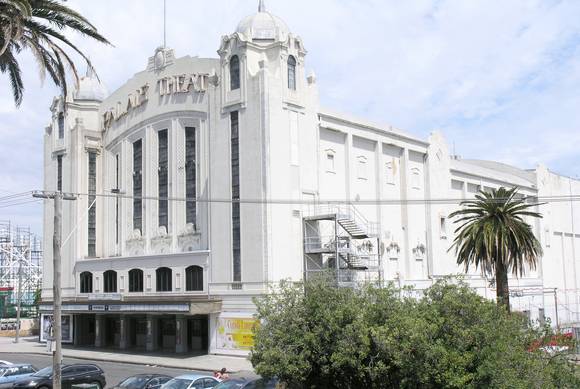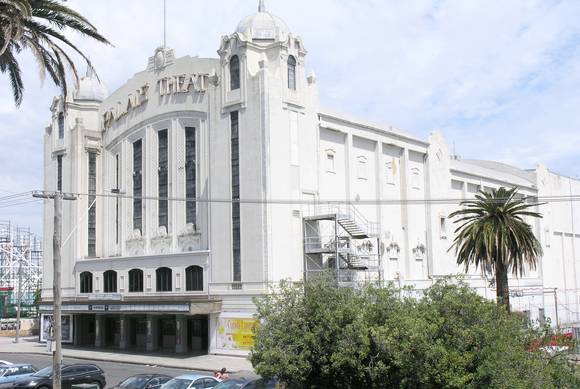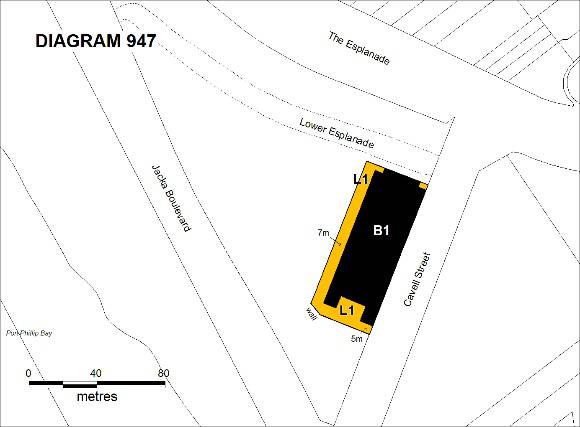| Back to search results » | Back to search page » |
|
PALAIS THEATRE
Location14 LOWER ESPLANADE ST KILDA, PORT PHILLIP CITY
File NumberPL-HE/03/1015 [1-9]LevelRegistered |
|
Statement of Significance
What is significant?
The Palais Theatre, St Kilda was constructed in 1927 as the Palais
Pictures, to a design by prominent Sydney-based theatre and cinema
architect, Henry E. White. It was built on leased Crown land for the
American entrepreneurs, Herman, Harold and Leon Phillips, who had
previously established Luna Park (1912) and the Palais de Danse (1913)
in St Kilda. The Palais Pictures building replaced an earlier Palais Pictures
which was built c1920 and destroyed by fire in 1926. It was designed
to seat up to 3000 patrons and incorporated generous backstage
facilities and a broad proscenium. Like its predecessor, the form of
the new Palais Pictures conformed to that of the adjacent Palais de
Danse, with the adoption of a curved, aircraft hangar-type structure. The Palais Theatre is a free-standing, rendered, concrete encased
steel frame building, with brick infill walls. The roof is a two
level, shallow-curved corrugated iron roof, supported on steel
trusses. Extensive use was made of steel framing, with the dress
circle cantilevered from a steel frame, to minimise the number of
columns required in the auditorium. The highly visible side and rear facades of the free-standing
building have minimal decoration, placing emphasis on the front
facade. Conceived as a signboard, the central section of this main
facade incorporates a large descriptive sign on a curved, rendered
parapet. Domed towers flank the facade in a similar manner to the Luna
Park entrance and the Palais de Danse facade. Wanting to convey a sense of modernity, Henry White stated that he
adopted no particular style in the design of the Palais Pictures
building. The interior, described at times as Spanish, French and
Oriental, includes a large, double-height entrance foyer with giant
order columns, and two sweeping staircases to the dress circle foyer
above. Walls are decorated with a disc-like surface pattern and
columns have a scagliola finish. Two open wells in the upper foyer, a
rectangular one over the lower foyer and an elliptical one over the
back stalls, are an important aspect of the design. In addition to the light
fittings, the building retains many other carefully resolved original
or early design features including: . Illuminated glass directional signs to the ladies and gentlemen's cloakrooms; . Illuminated exit signs; . Tip-up theatre seating, associated foot warmers and attendant piping; . Arm chair style seating and carved timber benches; . Wall-mounted usher's seating; . Stage curtains and wall and door drapes; and . Moulded spotlight housings. The place also contains an array of original and early service
equipment and some remnants of orchestra pit balustrading that
contributes to an understanding of how the theatre originally operated. After World War II some alterations were made to the building to
enable large live performances. The Palais Theatre subsequently became
home to the Elizabethan Theatre Trust's ballet and opera seasons, and
home to the Melbourne Film Festival from 1962 to 1981. Affected by the
opening of the Arts Centre theatres in the 1980s, the use of the
Palais Theatre became sporadic, and it has been used largely as a live
music venue since this time. In 1973 the outdoor promenade to the upper foyer was infilled across
the front facade, significantly altering the building's external appearance. The Bedford lights are significant to the cultural heritage
significance of the place and in their own right. Certain items within the building contribute to the heritage
significance of the place but do not warrant registration in their own
right. Their contribution relates to the intactness of the building
and its rarity, being directly related to the principal function of
the theatre. There are differing levels of significance of such
contributory items. The following items contribute to the significance of the Palais
Theatre to a high degree: tip-up theatre seating (seats bolted to the
floor in rows). foot warmers and attendant piping, row of illuminated
glazed panels to rear of stalls, wall mounted usher's seating,
illuminated exit signs, iron swivel rods for door drapes to stalls
fire exits, main front stage curtains with counter weights, ropes and
all fittings,leadlight wall mounted light fittings,carved timber bench
seats (large), arm chair style seating (lounge), built in balcony
moulded spot housings, dome (bio box) switch/power board. The following items make some contribution to the significance of the
Palais Theatre: White Rose boiler, power generator for projection room (different
circuit not in use), switch/power board, various power plant (some not
in use), ventilation system (in use), sections (various lengths) of
balustrading from orchestra pit, lengths wall drapes and fittings.
How is it significant?
The Palais Theatre, St Kilda is of architectural and historical
significance to the State of Victoria.
Why is it significant?
The Palais Theatre, St Kilda is
of architectural significance as an example of the work of prominent
and influential cinema architect, Henry E. White. It was his largest
theatre project in Melbourne and the only theatre designed, rather
than refurbished, by him in Victoria. The early/original decorative
scheme and the furniture and fittings, mainly designed by Melbourne
firm A.E. Higgins, enhance the significance of the theatre as does the
suite of William Bedford light fittings (some of which are now located
off-site). The Bedford lights are significant as they were
specifically designed for the Palais Theatre by a pre-eminent
manufacturer of lights and because of their rarity due to the
intactness of the suite of lights. The Palais Theatre, St Kilda is of historical significance for its
association with the development of St Kilda as an important seaside
resort and as an integral part of the St Kilda foreshore entertainment
complex. Its vast scale and solid construction reflect the confidence
in the location and the medium of film, by the 1920s. The Palais Theatre, St Kilda is of historical significance for its
continuous association with a major form of popular entertainment in
the twentieth century. This includes its original association with
American entrepreneurs, the Phillips brothers, and its continued
operation through the 1960s-1980s when many other amusements in the
vicinity were closed, demolished or burnt down.
Group
Recreation and Entertainment
Category
Theatre






